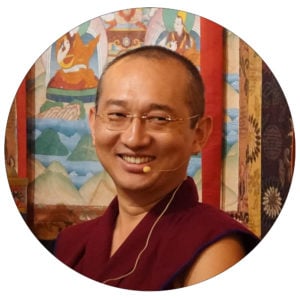Wisdom Dharma Chat | His Eminence Khangser Rinpoche (April 2025)
In this episode of Wisdom Dharma Chats, His Eminence Khangser Rinpoche returns for an enriching conversation with host Daniel Aitken. They begin with a brief reflection on Rinpoche’s recent book, A Monk’s Guide to Finding Joy, before expanding on themes explored in a prior Wisdom Dharma Chat with Yongey Mingyur Rinpoche and Professor Robert Thurman. Drawing from this earlier dialogue, Daniel and Rinpoche explore detailed nuances in how the sutra and tantra approaches to mental afflictions differ. They continue to explore the challenges of distraction in the digital age and the enduring resilience of the Dharma across generations before returning to Rinpoche’s book with a deeper look at the role of joy and devotion on the Buddhist path and how one can balance rigorous tantric practice with the cultivation of joy.
Rinpoche, vice abbot of Gyuto Tantric Monastery, shares personal stories of his upbringing, monastic discipline, and the profound influence of his teachers. His grounded presence and accessible teaching style offer viewers the opportunity to witness the timeless depth and modern relevance of Buddhist practice. Rinpoche concludes the episode with reflections on the importance of consistent practice and a gentle reminder that—even amidst chaos—joy remains both a compass and a companion on the path.
Meet Our Guest
 His Eminence Khangser Rinpoche
His Eminence Khangser Rinpoche
His Eminence Khangser Rinpoche was born in Kathmandu, Nepal, in May 1975. At five years of age, a search party positively identified him as the reincarnation of the seventh Khangser Rinpoche. He is one of three high lamas responsible for recognizing the rebirth of the spiritual leader of Tibet, His Holiness the Dalai Lama.
Khangser Rinpoche completed his preliminary study of Buddhist philosophy at the Institute of Buddhist Dialectics in Dharamshala, India. He later went on to advanced Buddhist studies in sutra and tantra at Sera Jey Monastery and Gyuto Tantric Monastic University. It was there he earned the geshe lharampa degree and a doctorate degree in tantra, both with the highest honors in the top division. Khangser Rinpoche presently serves as vice abbot of Gyuto Monastery and as the founder and administrative head of Thangkar Dechen Choling Monastic Institute. This institute is both a monastery and a school, and generously provides food, housing, and education in both Dharma and contemporary Western curricula to over eighty young monks in Nepal. The entire student population comes from impoverished conditions, many of whom are orphans.
Khangser Rinpoche has established many Dipkar centers around the globe, spearheading philanthropic efforts such as providing free food to those in need. He also established the Dipkar Vajrayana Institute to offer free Dharma education to all who wish to learn. Khangser Rinpoche is considered one of the great Buddhist teachers of the modern age. He has dedicated his entire life to providing spiritual medicine for what ails a broken spirit. He believes his mission is to help as many suffering beings as possible.
